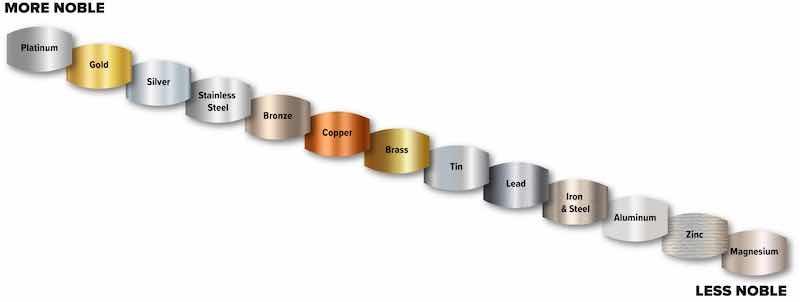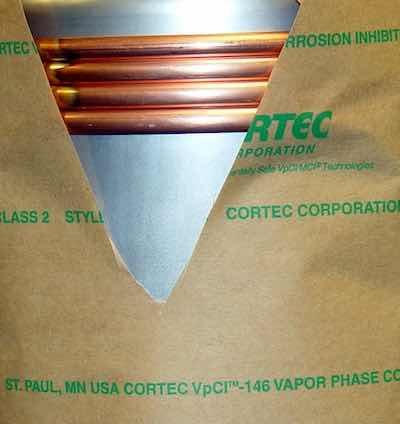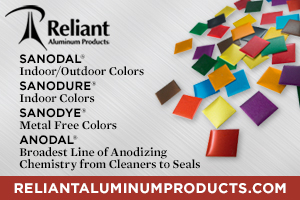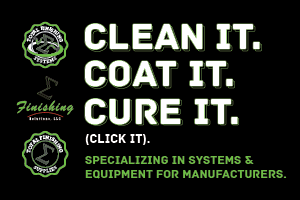They say that opposites attract, but when dissimilar metals come in contact, what they attract is corrosion.
This fatal flaw comes from two simple facts: Metal is reactive, and metal is conductive. Reactivity is the fundamental driver of corrosion, and conductivity allows the less reactive metal to transfer its corrosion woes to its more reactive neighbor. However, this process is not random; it is entirely predictable, thanks to something called the galvanic series.
What Is the Galvanic Series?
 Luke Stone and Julie HolmquistThe hierarchy of metals is at the heart of galvanic corrosion. Different types of metals are considered more or less noble and are arranged accordingly in the galvanic series.
Luke Stone and Julie HolmquistThe hierarchy of metals is at the heart of galvanic corrosion. Different types of metals are considered more or less noble and are arranged accordingly in the galvanic series.
Platinum and gold are at the top (more noble, less reactive), while aluminum and zinc (less noble, more reactive) are near the bottom. Yellow metals are positioned in the middle, with iron and steel being less noble than bronze and copper but more noble than aluminum and zinc.
When different types of metal that are far apart on the galvanic series come in contact with each other, the corrosion potential of the more noble metal will be shifted to the less noble metal.
Suppose you don’t have a way to electrically isolate those components. In that case, you will have a connection from one to the other that will preferentially drive corrosion onto specific parts of your system. In such cases, metals like copper will preferentially cause metals like steel to corrode.
Metals like steel are more likely to cause metals like aluminum to corrode. Metal contact points, such as fasteners made of different metals, are a good “canary in the coal mine” for identifying galvanic corrosion concerns.
 The galvanic series. Cortec image courtesy of Kim Sapp.
The galvanic series. Cortec image courtesy of Kim Sapp.
How to Avoid Galvanic Corrosion Surprises
Galvanic corrosion is interesting because, theoretically, it is something that can be entirely avoided, but in practice, it is very difficult to stop. It can take people by surprise as they focus on only one type of metal (e.g., steel) that they believe is most vulnerable to corrosion, completely overlooking other metals in the system.
While they may think that brass or aluminum do not require corrosion protection due to their better corrosion resistance in everyday situations, they will be doing themselves a severe disservice if they only protect one type of metal in the system; this will simply shift the corrosion attack down the line to the less noble metal.
 One example of VCI packaging that protects multiple metal types. Cortec image.For example, if they use a corrosion inhibitor for steel but not for copper, any corrosion reaction that occurs on the copper could be shifted to the steel as the sacrificial metal, creating a surprise for the person who had so carefully protected the more vulnerable metal. Alternatively, if steel and aluminum parts are combined in a package without protection for the steel, the corrosion that would normally occur on the steel could instead transfer to the aluminum.
One example of VCI packaging that protects multiple metal types. Cortec image.For example, if they use a corrosion inhibitor for steel but not for copper, any corrosion reaction that occurs on the copper could be shifted to the steel as the sacrificial metal, creating a surprise for the person who had so carefully protected the more vulnerable metal. Alternatively, if steel and aluminum parts are combined in a package without protection for the steel, the corrosion that would normally occur on the steel could instead transfer to the aluminum.
In contrast, if there’s no corrosion happening on brass or steel, it will not be able to force the steel or aluminum to sacrifice itself because nothing is pushing the proverbial boulder down the hill. The system can essentially remain in stasis until something initiates corrosion on the more noble metal. Think of it like flipping the switch and disconnecting the circuit. If the circuit isn’t running, then the steel isn’t pushing electrons into the aluminum, and neither the steel nor the aluminum is corroding.
Suppose someone can’t electrically isolate the copper from the steel or the steel from the aluminum in the system. In that case, it is possible to “flip the switch” by applying a form of corrosion protection that addresses all metal types. For example, VCI (vapor corrosion inhibitor) packaging materials, such as papers, films, or emitting materials, sometimes only contain corrosion inhibitors for ferrous metals (e.g., steel).
Others contain corrosion inhibitors for multiple metal types, and these should be selected when a variety of metals are in the package. The same is true for coatings or liquid rust preventatives: if you have more than one metal type in contact with each other, choose a rust preventative that will address all surfaces. If protection is good for each member of the metal “family” present, chances are reduced that one will take the brunt of the corrosion attack.
The Solution Starts By Recognizing the Problem
Understanding the dynamics of the galvanic series and the hierarchy of metals is the first step in avoiding galvanic corrosion. While engineers creating a system must take many factors into account when combining multiple metal types, it is also important for the average person working with metals to be aware of potential concerns. Recognizing the presence of multiple metals in a package or system and taking steps to protect all metal types is a prudent move in the right direction to prevent transferring corrosion issues from one metal to another.
Luke Stone (Lstone@cortecvci.com) is a technical service engineer, and Julie Holmquist (Jholmquist@cortecvci.com) is a content writer at Cortec Corporation, a manufacturer of corrosion inhibitors and packaging solutions for industries worldwide. Learn more at https://www.cortecvci.com.



































